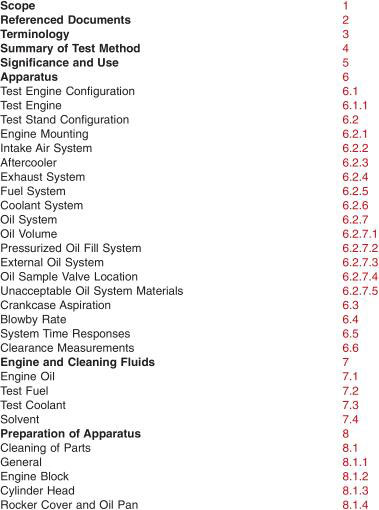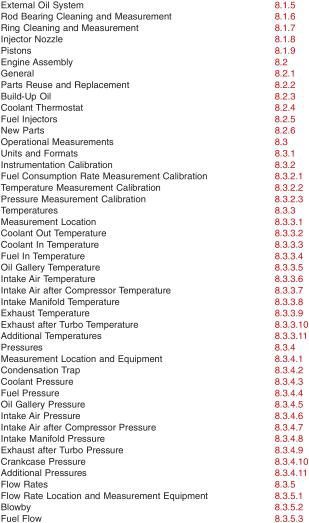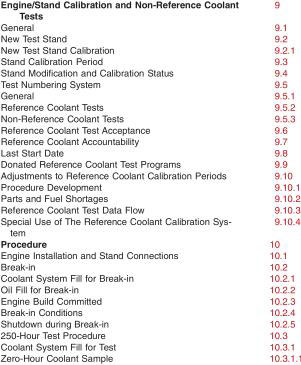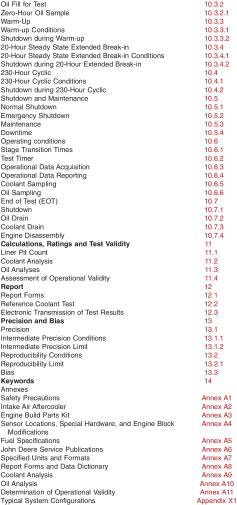1. Scope
1.1 This test method is commonly referred to as the John Deere Cavitation Test. The test method defines a heavy-duty diesel engine to evaluate coolant protection as related to cylinder liner pitting caused by cavitation.
1.2 The values stated in SI units are to be regarded as the standard. The values given in parenthesis are for information only. The only exception is where there is no direct SI equivalent such as screw threads, national pipe threads/diameters, and tubing sizes.
1.3 This standard does not purport to address all of the safety concerns, if any, associated with its use. It is the responsibility of the user of this standard to establish appropriate safety and health practices and determine the applicability of regulatory limitations prior to use. See Annex A1 for general safety precautions.
1.4 Table of Contents:




2. Referenced Documents
2.1 ASTM Standards:
D86 Test Method for Distillation of Petroleum Products at Atmospheric Pressure
D93 Test Methods for Flash Point by Pensky-Martens Closed Cup Tester
D97 Test Method for Pour Point of Petroleum Products
D130 Test Method for Corrosiveness to Copper from Petroleum Products by Copper Strip Test
D235 Specification for Mineral Spirits (Petroleum Spirits) (Hydrocarbon Dry Cleaning Solvent)
D287 Test Method for API Gravity of Crude Petroleum and Petroleum Products (Hydrometer Method)
D445 Test Method for Kinematic Viscosity of Transparent and Opaque Liquids (and Calculation of Dynamic Viscosity)
D482 Test Method for Ash from Petroleum Products
D524 Test Method for Ramsbottom Carbon Residue of Petroleum Products
D613 Test Method for Cetane Number of Diesel Fuel Oil
D664 Test Method for Acid Number of Petroleum Products by Potentiometric Titration
D976 Test Method for Calculated Cetane Index of Distillate Fuels
D1121 Test Method for Reserve Alkalinity of Engine Coolants and Antirusts
D1177 Test Method for Freezing Point of Aqueous Engine Coolants
D1287 Test Method for pH of Engine Coolants and Antirusts
D1319 Test Method for Hydrocarbon Types in Liquid Petroleum Products by Fluorescent Indicator Adsorption
D2274 Test Method for Oxidation Stability of Distillate Fuel Oil (Accelerated Method)
D2500 Test Method for Cloud Point of Petroleum Products
D2622 Test Method for Sulfur in Petroleum Products by Wavelength Dispersive X-ray Fluorescence Spectrometry
D2709 Test Method for Water and Sediment in Middle Distillate Fuels by Centrifuge
D4052 Test Method for Density, Relative Density, and API Gravity of Liquids by Digital Density Meter
D4485 Specification for Performance of Active API Service Category Engine Oils
D4737 Test Method for Calculated Cetane Index by Four Variable Equation
D5185 Test Method for Determination of Additive Elements, Wear Metals, and Contaminants in Used Lubricating Oils and Determination of Selected Elements in Base Oils by Inductively Coupled Plasma Atomic Emission Spectrometry (ICP-AES)
D5302 Test Method for Evaluation of Automotive Engine Oils for Inhibition of Deposit Formation and Wear in a Spark-Ignition Internal Combustion Engine Fueled with Gasoline and Operated Under Low-Temperature, Light-Duty Conditions (Withdrawn 2003)
D5844 Test Method for Evaluation of Automotive Engine Oils for Inhibition of Rusting (Sequence IID) (Withdrawn 2003)
D5967 Test Method for Evaluation of Diesel Engine Oils in T-8 Diesel Engine
E29 Practice for Using Significant Digits in Test Data to Determine Conformance with Specifications
E202 Test Methods for Analysis of Ethylene Glycols and Propylene Glycols
E344 Terminology Relating to Thermometry and Hydrometry
3. Terminology
3.1 Definitions:
3.1.1 blind reference coolant, n - a reference coolant, the identity of which is unknown by the test facility.
3.1.2 blowby, n - in internal combustion engines, the combustion products and unburned air-and-fuel mixture that enter the crankcase.
3.1.3 calibrate, v - to determine the indication or output of a measuring device with respect to that of a standard.
3.1.4 heavy-duty, adj - in internal combustion engine operation, characterized by average speed, power output, and internal temperatures that are close to the potential maximum.
3.1.5 heavy-duty engine, n - in internal combustion engines, one that is designed to allow operation continuously at or close to its peak output.
3.1.6 non-reference coolant, n - any coolant other than a reference coolant, such as a research formulation, commercial coolant or candidate coolant.
3.1.7 non-standard test, n - a test that is not conducted in conformance with the requirements in the standard test method; such as running in an non-calibrated test stand or using different test equipment, applying different equipment assembly procedures, or using modified operating conditions.
3.1.8 reference coolant, n - a coolant of known performance characteristics, used as a basis for comparison.
3.1.9 test coolant, n - any coolant subjected to evaluation in an established procedure.
3.1.10 wear, n - the loss of material from, or relocation of material on, a surface.
3.1.10.1 Discussion - Wear generally occurs between two surfaces moving relative to each other, and is the result of mechanical or chemical action or by a combination of mechanical and chemical actions.
3.2 Definitions of Terms Specific to This Standard:
3.2.1 cylinder liner, n - in internal combustion engines, the replaceable cylinders in which the pistons move up and down and combustion takes place.
3.2.2 overhead, n - in internal combustion engines, the components of the valve train located in or above the cylinder head.
3.2.3 valve train, n - in internal combustion engines, the series of components, such as valves, crossheads, rocker arms, push rods and camshaft, that open and close the intake and exhaust valves.